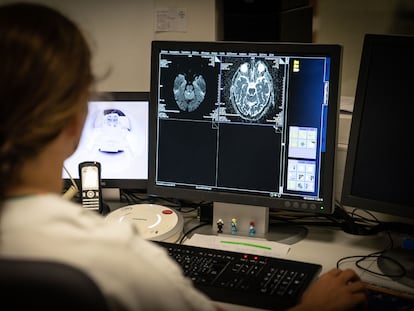This scientist studied her own brain to explain why the benefits of a good night’s sleep can be felt 15 days later
A longitudinal study, based on 30 brain scans and hundreds of physiological data points, suggests that the positive effects of exercise and sleep can be observed for up to two weeks

For five months, every Monday and Friday, Ana Triana Hoyos watched 10 minutes of The Grand Budapest Hotel. It’s not that this Colombian neurologist is a die-hard Wes Anderson fan. “The film is fine, but when you’ve seen it 30 times it loses its charm,” she explains in a video interview. She didn’t do it for fun, but for work. During these sessions, a device recorded her brain activity. It also recorded her brain activity while she performed mental agility and reflex exercises. And while she gave her brain a rest and let her mind wander.
The goal of the study was to track changes in her brain activity over several months and link them to her physical and psychological activities, which she monitored using a phone, a watch, and a smart ring. Hoyos aimed to study the brain “not as an independent, isolated organ, but in relation to external factors.” Through this research, she concluded that exercise, sleep, stress, and mood all influence brain activity. These effects, like an echo or shadow, gradually fade but linger in the brain for approximately 15 days.
Most studies on the human brain involve numerous participants but collect limited data, often offering only a snapshot of a single moment without considering how the brain evolves over time or how external factors influence it. Hoyos, a neurology researcher at the University of Altos in Finland, sought to take the opposite approach, embracing both the limitations and strengths that come with it. To achieve this, she decided to study one brain in depth — her own. The findings of her study were published on Tuesday in the scientific journal PLoS Biology.
“There’s a nice analogy that [Harvard University neurologist] Sebastian Seung uses,” Hoyos recalls. “Neuronal activity is like the flow of a river, never remaining the same, always changing and shifting.” Building on this idea, Hoyos aimed not to capture a static snapshot of brain activity but to create a dynamic “video,” observing how the flow evolves over time and how external factors influence it. “If I throw a stone into the water today, how will it affect the flow? What if it rains? How long will the ripples last?” she asks.
For this study, data were collected over 133 days, including 30 fMRI scans that measured attention, memory (using brain games), resting state, and responses to naturalistic stimuli (by showing 10 minutes of The Grand Budapest Hotel). Hoyos analyzed her reflexes and memory, correlating them with behavioral, physiological, and lifestyle factors. These were then compared based on two time frames: the most recent data from the past week and older data from the previous week, allowing her to examine both immediate and delayed effects of external influences on brain activity.
This study echoes the work of Stanford scientist Russell Poldrack, who nearly a decade ago analyzed his own brain activity for 18 months to observe how external factors, such as caffeine intake, reprogrammed his brain connections. Hoyos acknowledges the similarities between the two studies, though they can be seen as complementary. Poldrack’s study focused on food and drink, while Hoyos’ research looks at sleep, emotions, and exercise. The decade between the two studies also marks a technological leap: Poldrack relied on questionnaires to measure external factors, whereas Hoyos used devices that objectively recorded physiological data.
“This study shows that external factors can influence our brains, even modifying them in some way,” says Jesús Romero, president of the Andalusian Society of Neurology.
The neurologist — who was not involved in the research — believes that this is important to analyze how the brain makes decisions and how it is shaped by learning. “In a more philosophical sense, this study suggests that by choosing a better environment, we allow our brains to be influenced by more beneficial experiences, which in turn enhances brain connectivity,” the expert concludes.
Hoyos acknowledges that balancing the roles of both scientist and subject can be “complicated.” To maintain the integrity of the experiment, her team followed a strict methodology: while she collected the data, she was not allowed to analyze it until the project concluded, five months later. Upon reviewing the results, Hoyos noticed, for instance, how lack of sleep negatively impacted her brain activity. Poor sleep quality was associated with reduced connectivity in several brain regions.
Hoyos acknowledges that the finding wasn’t particularly surprising — it was fairly intuitive. “It’s a bit like proving that water is wet,” she explains. “But scientifically proving that water is wet is not so simple.” However, the study also revealed some less expected results, such as the positive effects of physical activity, which significantly improved her performance in agility and reflex tests. Another surprising discovery was that her performance wasn’t linked to how many hours she slept, but rather the quality of that sleep. “Although, of course, this might just be a peculiarity of mine,” she concedes.
This is the main limitation of the study: while it provides a detailed understanding of a specific brain, it’s challenging to extrapolate its findings to the general population. “Psychology exists because no two individuals are the same,” explains Ignacio Morgado, a professor of Psychobiology at the Autonomous University of Barcelona, who was not involved in the research. “Studies with a single subject can be suggestive, but they can never be considered conclusive.”
Without delving into the intricate details of Hoyos’ brain, it is reasonable to assume that the lasting impact of external factors on brain function is likely a common phenomenon. This idea is particularly intriguing, as the expert points out. Typically, one might expect that if you experience stress, poor sleep, or inactivity on one day, your agility and brain activity would be diminished the following day. However, what is less obvious is that these effects can linger, resembling concentric waves rippling through a river — each wave becoming progressively weaker and spreading further from the source.
Now, Hoyos aims to explore the extent of these ripples. Do they dissipate after two weeks, or do they continue to influence the brain’s trajectory in some way? She also is seeking to understand whether the effects are cumulative over time. What occurs when the accumulation of these external factors becomes excessive? “How many stones must you throw to change the river’s course? Does the river overflow when it has been raining for a long time?”
Sign up for our weekly newsletter to get more English-language news coverage from EL PAÍS USA Edition
Tu suscripción se está usando en otro dispositivo
¿Quieres añadir otro usuario a tu suscripción?
Si continúas leyendo en este dispositivo, no se podrá leer en el otro.
FlechaTu suscripción se está usando en otro dispositivo y solo puedes acceder a EL PAÍS desde un dispositivo a la vez.
Si quieres compartir tu cuenta, cambia tu suscripción a la modalidad Premium, así podrás añadir otro usuario. Cada uno accederá con su propia cuenta de email, lo que os permitirá personalizar vuestra experiencia en EL PAÍS.
¿Tienes una suscripción de empresa? Accede aquí para contratar más cuentas.
En el caso de no saber quién está usando tu cuenta, te recomendamos cambiar tu contraseña aquí.
Si decides continuar compartiendo tu cuenta, este mensaje se mostrará en tu dispositivo y en el de la otra persona que está usando tu cuenta de forma indefinida, afectando a tu experiencia de lectura. Puedes consultar aquí los términos y condiciones de la suscripción digital.
More information
Últimas noticias
The Florida Keys tourist paradise is besieged by immigration agents: ‘We’ve never seen anything like this’
The latest scam on WhatsApp behind the legal dream: using immigration status as bait
Oil, gold and rare earth elements: the backdrop to US political tension with Venezuela
The open war against the oil ‘phantom fleet’
Most viewed
- Families demand repatriation of bodies of Colombians who died in Ukraine: ‘This war is a slaughterhouse for foreigners’
- The low-cost creative revolution: How technology is making art accessible to everyone
- Liset Menéndez de la Prida, neuroscientist: ‘It’s not normal to constantly seek pleasure; it’s important to be bored, to be calm’
- Christian Louboutin: ‘Young people don’t want to be like their parents. And if their parents wear sneakers, they’re going to look for something else’
- ‘El Limones’ and the growing union disguise of Mexican organized crime











































